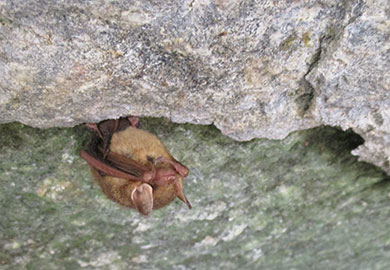DNR News** Archived Article - please check for current information. **
Deadly bat fungus in three new South Carolina counties March 14, 2018
by Jennifer Kindel, SCDNR Wildlife Biologist

Tri-colored bat populations in the Upstate have declined at an alarming rate, up to 97 percent, since white-nose syndrome (WNS) arrived in South Carolina. WNS is now present in three new counties in South Carolina: Cherokee, Spartanburg and York. (SCDNR photo by Jennifer Kindel)
The fungus that causes the devastating bat disease white-nose syndrome (WNS) is now present in three new counties in South Carolina: Cherokee, Spartanburg and York.
The South Carolina Department of Natural Resources (SCDNR) recently received confirmation from the National Wildlife Health Center that the fungus was present on bats in these three counties. No obvious signs of WNS were seen on any of the 83 tri-colored bats observed in mid-February, when fungal growth has had the chance to become established. However, results showed the fungus was present on 25 percent of the bats tested.
A total of 10 counties in South Carolina have now been reported to have the fungus. The three new counties fill Upstate gaps already suspected to harbor the fungus--Greenville, Lancaster, Laurens and Union were counties added in 2017. In the past, sites in Oconee, Pickens and Richland had bats dying from WNS.
Sadly, tri-colored bat populations in major Upstate hibernacula have declined at an alarming rate, up to 97 percent, since WNS arrived in South Carolina. After a total decline of 91 percent at one major site after only three years, the most recent count shows a slowdown in the decline. But it doesn’t leave much: only 30 bats where once there were hundreds.
Small numbers of banded tri-colored bats have returned to this site, providing a glimmer of hope that they could persist. Some bats in other states are also showing signs of resistance or adaptation to the disease. But because bats have very low reproductive rates, recovery from these losses amidst other major threats such as habitat loss may take a long time. With still no cure or feasible treatment for WNS, formerly common bats are becoming rare, and some rare bat species may be lost completely.
Bats don’t die from WNS directly, but from thirst or starvation when the fungal infection wakes them from hibernation during a time there isn’t much to eat or drink. Not seeing any obvious clinical signs of WNS on these bats in mid-February is encouraging because these individuals may be able to survive until spring.
Tri-colored bats have a long exposure time to the cold-loving fungus. Other susceptible hibernating bat species in South Carolina include big brown bats, little brown bats, Eastern small-footed bats, Northern long-eared bats and Southeastern bats. So far in South Carolina, WNS has only been confirmed in tri-colored and Eastern small-footed bats. Elsewhere, the fungus has been found on Rafinesque’s big-eared bats but have not appeared to be affected by the disease. In 2017, the first cases of Southeastern bats suffering from WNS were reported out of Alabama. WNS is now confirmed in 31 states and five Canadian provinces, and the fungus has been detected in two additional states.
Jennifer Kindel is an SCDNR wildlife biologist and white-nose syndrome specialist based in Union.
DNR Media Contacts
| Area | Personnel | Number |
|---|---|---|
| Coastal | David Lucas | 843-610-0096 |
| Marine | Erin Weeks | 843-953-9845 |
| Midlands | Kaley Nevin | 803-917-0398 |
| Upstate | Greg Lucas | 864-380-5201 |
After Hours Radio Room - 803-955-4000
